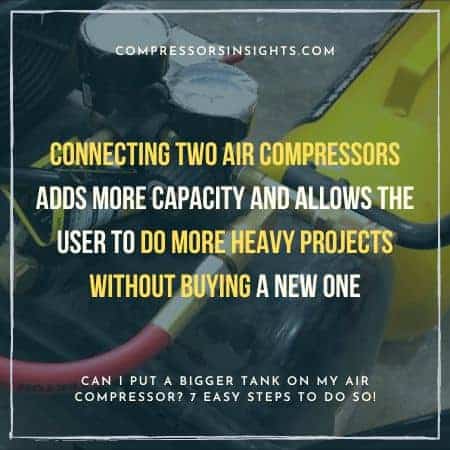Can I Put a Bigger Tank on My Air Compressor? 7 Easy Steps To Do So!
TheToolGeeks.com is a participant in the Amazon Services LLC Associates Program and other affiliate advertising programs. We may earn from qualifying purchases. (Learn More).
Bigger tanks are always useful. It helps in handling bigger projects and for continuous use. But if you have a small air compressor tank, but you have to handle a big project or heavy air tools, what would you do? In this situation, some people buy a new air compressor, while some think of adding a reserve tank to their air compressors.
Yes, adding more capacity compressor helps do more work, and you will not have to waste your time letting it rest to build up its pressure. But, can I put a bigger tank on my air compressor? If yes, how can I do it?
You can connect two compressor tanks with one compressor following a few steps, which we will discuss further in the article!

Why Should One Connect Two Air Compressors Tank?
When someone connects two air tanks to one air compressor, what are things which is beneficial? Adding another tank increases storing capacity of the compressor, and the user can use the compressor without wasting time.
It increases the use duration without taking breaks to let it build up the pressure again. Compressor with more air pressure build-up helps in handling heavy-duty jobs.
Can I Put a Bigger Tank on My Air Compressor?
Yes, you can put a bigger second air tank on the compressor. This will help in producing more pressure and storing more pressure. This will also help in doing the project continuously without needing to stop and wait for the compressor to fill again.
More tank capacity means continuous working time without wasting your precious time!!. The replacement tank needs to be of the same brand (For better performance)
Changes you Might notice after Adding a Bigger Portable Tank
When you add another tank to your compressor, you will notice a few things; you will notice that your compressor will take more time to build up the tank pressure. This is because there is a double tank to fill.
What About Adding a Reserve Tank?
Instead of spending more money on an extra air compressor, you can surely buy an additional air tank. This will add space to your air compressor without buying another. Adding another tank will increase the capacity and will also help you to do work with your compressor.
The reserve tank you can attach when you need it, and otherwise, you can store it. But ensure to drain and dry the tank and then store it.
How to Connect Two Tanks?
Connecting two air compressors adds more capacity and allows the user to do more heavy projects without spending too much money on buying another larger tank capacity compressor.
Connecting two compressor tanks is easy, but you need to be aware of the tools and parts and follow these below-mentioned steps to successfully attach your additional tank.
1. Unplug the Air Compressor
Firstly make sure to unplug your compressor. Never touch your compressor while it’s still plugged. This is because it increases the risk of electric shock and can damage the compressor permanently.
2. Gather Fittings & Accessories
Secondly, gather all the fitting and accessories you need while connecting your additional air tank. Buy the additional tank higher than the tank you have. If you have 100 psi, then buy a 125 psi compressor.
Buy two female NPT brass couplers of ½ to ⅜” and a ⅜ to ¼.” Then buy a ¼” NPT brass tee with an air compressor hose and a silicone adhesive.
3. Drain your Air Compressor
Before doing anything else with your air compressor:
- Release the compressed air in the original air compressor tank.
- Always drain your compressor after using it.
- Drain the compressor and moisture. It helps in avoiding explosions.
It also reduces the durability of the compressor.
4. Replace Safety Valve with the Tee
Then the main work starts!!. Using a wrench, remove your compressor’s safety valve. Prepare your brass tee after removing it using a silicone adhesive around the male side of the thread. Then install your tee on the exact place where you have removed the safety valve.
Then, prepare your silicon and install a safety valve on the female end of the brass tee (top one). After doing all this, attach your compressor air hose to the female side of the brass tee (bottom). Ensure to attach everything carefully and do not over-tight them. Just tight enough, so it does not leak.
5. Ready your New Air Compressor Tank
Prepare your new air tank and make sure you have everything arranged. The entire tank should be higher Gallons than the previous one, and the fitting and attachments should be good to go!!
6. Attach new Air Compressor Tank
Now, you must prepare your air compressor’s tank and disassemble the top of the tank. Then attach the new couplers to the area where you have just removed assembled pieces. To do this, apply adhesive on the male thread of the coupler ( ½” to ⅜”).
Next, install the coupler on the top of the tank using a wrench or impact driver. After this, screw the ⅜” to ¼” in the coupler we installed before using adhesive. It’s time to take the other end of the tank hose and attach it to the reducer.
7. Fill the New Tank With the Air
Lastly, fill your new air tank: the air will go to the tank through a brass tee when you set the dial near. Plug in the compressor and check if all the parts and unit is working according to their work.
Then, set your air compressor psi according to the capacity of the new tank and allow it to build up the pressure. When the tank is filled, set your dial at the open point; after turning it on, you will transfer your weak air compressor into a larger and powerful/heavy-duty working compressor.

Important Considerations When Connecting A Second Tank
While connecting your compressor tank with another new tank, ensure to consider a few things:
- Check the duty cycle: ensure it has enough duty cycle to allow it to cool down because otherwise, it will burn the compressor.
- It is not ideal for adding another compressor for continuous use. It is great for intermittent use.
- The compressor will take double the time to refill the tanks.
- The size of the compressor tank matter. Choose more than you already have a capacity compressor.
Should I Care about the Tank Size of an Air Compressor?
Yes, the large tank size gives more time duration for working. With a high volume of air, the compressor will work for more time duration. If you need your tank for continuous use and heavy projects, you will have to care about tank size. For normal use, 5-10 Gallons are ok, but for professional use, at least 40-80 Gallon tank is used ( based on using time duration).
Conclusion
Compressors have tanks with them to allow air storage, but sometimes you may need more air when you have a little extra heavy-duty project. Then what to do? Can I add a bigger tank to my air compressor or an extra tank?
Adding another tank will allow for more storage capacity and more using time. More capacity only means that while you have already built up the pressure, you will not have to wait again to let it fill, but you can start using the already built-up second compressor tank.
Keep in mind this process is for temporary use, not for professional or regular use. This is because it will affect the air compressor motor and ultimately damage the unit,
FAQs
Can you add an extra tank to an air compressor?
Yes, you can add an extra tank to your air compressor. That will add reserved air for your while working on the project. But this also means the compressor will take longer to build up pressure in both tanks.
Is a bigger tank better for an air compressor?
Yes, a bigger tank is always better because it adds stored air and helps work continuously during a project. It also depends on the working (for professionals, larger tanks are necessary).
Does air compressor tank size matter?
Tanks store air; there are more things to consider, for example, a large compressor pump and motor, which helps produce more air. If you do not want a compressor for heavy working, then 4-6 Gallon are enough.
Can you change the tank of the air compressor?
Yes, you can change your air compressor’s tank. You can also add a tank to your compressor to increase storage capacity.
Amazon and the Amazon logo are trademarks of Amazon.com, Inc, or its affiliates.
